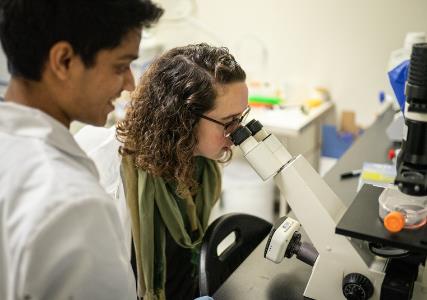
2020 is looking to be a promising year in ALS research on many different fronts. On January 24, ALS TDI Chief Executive Officer, Steve Perrin, Ph.D., and Chief Scientific Officer, Fernando Viera, M.D., conducted a webinar for members of the ALS community where they discussed some of the most exciting news on the horizon. For those who missed the live presentation, or attendees who want to refresh their memories, here’s a summary of the 5 things they covered:
1. The first ALS Platform Trial: A platform trial is a newer approach to clinical trials that tests several drugs for the same disease in one group of people at the same time. In a traditional clinical trial, one drug is tested in one group, with a placebo group for a control. In a platform trial, many different drugs can be tested and compared to a single placebo group. Drugs that prove ineffective can be removed from the trial and replaced with other promising candidates throughout the process. This reduces the number of patients that end up receiving a placebo rather than an experimental treatment and speeds up the development pipeline. These trials have been rising in popularity in cancer research in recent years. The first platform trial for ALS, led by Merit Cudkowicz, M.D. of Massachusetts General Hospital and the Healey Center for ALS, will begin early this year. It will evaluate 5 drugs simultaneously. Three of those drugs, Zilucoplan, CNM-Au8 and Verdiperstat, received FDA authorization for use in the trial on January 27. For more information, you can visit the trial's website here.
2. A new potential ALS biomarker: Researchers have been searching for a reliable ALS biomarker or a “biological fingerprint” that can reliably diagnose or predict disease progression, for as long as they have been investigating the disease. This year, ALS TDI and other researchers in the ALS space will be looking into neurofilament light chain (NF-L), a possible biomarker of ALS disease progression. Neurofilaments, and specifically neurofilament light chains, are proteins that are part of the exoskeleton of a neuron. Research has shown NFL levels are increased in ALS patients compared to controls and levels correlate with disease progression. NF-L levels in cerebrospinal fluid and blood increase when ALS symptoms become more severe, presumably because, as neurons degenerate, the components of the exoskeleton are released into those fluids.
3. ALS TDI’s Precision Medicine Program: The Precision Medicine Program (PMP) is the most comprehensive and longest-running translational research study in ALS. Through PMP, researchers at ALS TDI partner with people with ALS around the world to share and gather data on voice, movement, lifestyle, medical and family histories, genetics, biomarkers, and patient cell biology to better understand the disease. 2020 promises to be a big year for the PMP, as we continue our partnership with Google for data collection and analysis through artificial intelligence. This year we will publish the first results from this collaboration, in which PMP participants participated in voice recordings and accelerometers to record data about their speech and movement. With the help of Google’s artificial intelligence technology to interpret this data, we hope to demonstrate how this data can be reliably used as an objective measure of disease progression.
4. Project Euphonia: Speech recognition technology in products like phones, computers and smart speakers can be valuable for people with limited mobility. Unfortunately, these products can be difficult to use for people with impaired speech. A further collaboration between ALS TDI and Google, Project Euphonia seeks to train Google’s AI speech recognition algorithms to better interpret ALS-affected speech using data collected through the Precision Medicine Program. The project was also highlighted in an episode in an episode of Robert Downey Jr.’s YouTube series, the Age of AI, late last year.
5. Clinical results to watch for in 2020: There are three potential treatments in clinical trials that should be announcing updates in 2020.
AMX0035, developed by Amylyx Pharmaceuticals, is an oral treatment that could reduce nerve cell death due to ALS. Late last year, Amylyx reported that AMX0035 demonstrated a significant treatment benefit for people with ALS in their completed Phase 2 trial. The company will provide an update on regulatory plans and further details on expanded access in early 2020.
NurOwn, developed by Brainstorm Cell Therapeutics, is a stem cell-based treatment that uses MSCs harvested from the patient. MSCs are precursor cells that have the ability to differentiate into various cell types. NurOwn’s technology encourages MSCs to develop into cells that secrete neurotrophic factors (NTFs), or factors that promote the growth of nervous tissue. NTFs can also help nerve cells survive through their own neuroprotective function. The top-line data from a phase 3 trial will be available in late 2020.
Arimoclomol, developed by Orphazyme, is a small molecule agonist of HSF1a, a master regulator of the heat shock response. ALS is known to clump together misfolded proteins. Arimoclomolis is intended to clear these protein clumps by increasing the production of heat shock proteins which break down unwanted cell parts. A phase 2B/3 trial is scheduled to finish in August 2020.
Thank you go everyone who attended our webinar! For updates on research news and future webinars, make sure to subscribe to our ALS TDI email updates.